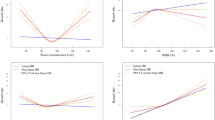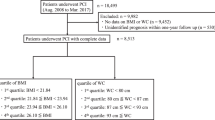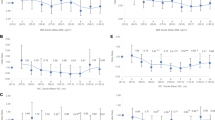Abstract
Objective:
Obesity is an independent cardiovascular risk factor, but its prognostic role in patients with peripheral arterial disease (PAD) is not well defined. Accordingly, we assessed the impact of body mass index (BMI) and waist circumference (WC) on cardiovascular risk in a homogeneous cohort of PAD patients.
Methods:
BMI and WC were measured in 190 consecutive PAD patients with ABI <0.90, referred to our university hospital for intermittent claudication. The occurrence of cardiac, cerebrovascular and peripheral events was prospectively assessed. The ability to classify risk was determined by calculating the hazard ratios (HRs) and c-statistics.
Results:
During a median follow-up of 31.5 months, 63 patients (33.2%) had a cardiovascular event. Considered as continuous variables, both adiposity indices were significantly associated with increased cardiovascular risk, even after adjustment for possible confounding factors (HR=1.08, 95% CI 1.01–1.15, P=0.045 for BMI and HR=1.04, 95% CI 1.01–1.07, P=0.004 for WC). When BMI and WC were included together in a fully adjusted Cox model, the significant association between BMI and cardiovascular risk disappeared (HR=0.98, 95% CI 0.88–1.10, P=0.772), whereas WC remained significantly associated with a worse outcome (HR=1.04, 95% CI 1.01–1.08, P=0.033). The better discriminative ability of WC vs BMI was confirmed by the c-statistic, which was significantly higher for WC (0.63, 95% CI 0.56–0.70) than for BMI (0.56, 95% CI 0.51–0.63, P=0.038).
Conclusions:
Abdominal obesity and, to a lesser degree, general obesity worsen the prognosis of PAD patients independently of possible confounding factors. Weight reduction should be integrated in the active management of these patients.
This is a preview of subscription content, access via your institution
Access options
Subscribe to this journal
Receive 12 print issues and online access
$259.00 per year
only $21.58 per issue
Buy this article
- Purchase on Springer Link
- Instant access to full article PDF
Prices may be subject to local taxes which are calculated during checkout


Similar content being viewed by others
References
Kenchaiah S, Evans JC, Levy D, Wilson PW, Benjamin EJ, Larson MG et al. Obesity and the risk of heart failure. N Engl J Med 2002; 347: 305–313.
Yusuf S, Hawken S, Ounpuu S, Bautista L, Franzosi MG, Commerford P, et al., INTERHEART Study Investigators. Obesity and the risk of myocardial infarction in 27 000 participants from 52 countries: a case–control study. Lancet 2005; 366: 1640–1649.
Gelber RP, Gaziano JM, Orav EJ, Manson JE, Buring JE, Kurth T . Measures of obesity and cardiovascular risk among men and women. J Am Coll Cardiol 2008; 52: 605–615.
Canoy D, Boekholdt SM, Wareham N, Luben R, Welch A, Bingham S et al. Body fat distribution and risk of coronary heart disease in men and women in the European Prospective Investigation into Cancer and Nutrition in Norfolk cohort: a population-based prospective study. Circulation 2007; 116: 2933–2943.
Rea TD, Heckbert SR, Kaplan RC, Psaty BM, Smith NL, Lemaitre RN et al. Body mass index and the risk of recurrent coronary events following acute myocardial infarction. Am J Cardiol 2001; 88: 467–472.
Kaplan RC, Heckbert SR, Furberg CD, Psaty BM . Predictors of subsequent coronary events, stroke, and death among survivors of first hospitalized myocardial infarction. J Clin Epidemiol 2002; 55: 654–664.
Galal W, van Domburg RT, Feringa HH, Schouten O, Elhendy A, Bax JJ et al. Relation of body mass index to outcome in patients with known or suspected coronary artery disease. Am J Cardiol 2007; 99: 1485–1490.
Oreopoulos A, Padwal R, Kalantar-Zadeh K, Fonarow GC, Norris CM, McAlister FA . Body mass index and mortality in heart failure: a meta-analysis. Am Heart J 2008; 156: 13–22.
Zeller M, Steg PG, Ravisy J, Lorgis L, Laurent Y, Sicard P, et al., RICO Survey Working Group. Relation between body mass index, waist circumference, and death after acute myocardial infarction. Circulation 2008; 118: 482–490.
Rankinen T, Kim SY, Pérusse L, Després JP, Bouchard C . The prediction of abdominal visceral fat level from body composition and anthropometry: ROC analysis. Int J Obes Relat Metab Disord 1999; 23: 801–809.
Snijder MB, van Dam RM, Visser M, Seidell JC . What aspects of body fat are particularly hazardous and how do we measure them? Int J Epidemiol 2006; 35: 83–92.
Weitz JI, Byrne J, Clagett GP, Farkouh ME, Porter JM, Sackett DL et al. Diagnosis and treatment of chronic arterial insufficiency of the lower extremities: a critical review. Circulation 1996; 94: 3026–3049.
Criqui MH, Langer RD, Fronek A, Feigelson HS, Klauber MR, McCann TJ et al. Mortality over a period of 10 years in patients with peripheral arterial disease. N Engl J Med 1992; 326: 381–386.
O’Riordain DS, O’Donnell JA . Realistic expectations for the patient with intermittent claudication. Br J Surg 1991; 78: 861–863.
Brevetti G, Martone VD, Perna S, Cacciatore F, Corrado S, Di Donato A et al. Intermittent claudication and risk of cardiovascular events. Angiology 1998; 49: 843–848.
Yudkin JS, Stehouwer CD, Emeis JJ, Coppack SW . C-reactive protein in healthy subjects: associations with obesity, insulin resistance, and endothelial dysfunction: a potential role for cytokines originating from adipose tissue? Arterioscler Thromb Vasc Biol 1999; 19: 972–978.
Tonkin A . The metabolic syndrome—a growing problem. Eur Heart J Suppl 2004; 6: 37–42.
Vidula H, Tian L, Liu K, Criqui MH, Ferrucci L, Pearce WH et al. Biomarkers of inflammation and thrombosis as predictors of near-term mortality in patients with peripheral arterial disease: a cohort study. Ann Intern Med 2008; 148: 85–93.
Brevetti G, Schiano V, Laurenzano E, Giugliano G, Petretta M, Scopacasa F et al. Myeloperoxidase, but not C-reactive protein, predicts cardiovascular risk in peripheral arterial disease. Eur Heart J 2008; 29: 224–230.
Brevetti G, Laurenzano E, Giugliano G, Lanero S, Brevetti L, Luciano R et al. Metabolic syndrome and cardiovascular risk prediction in peripheral arterial disease. Nutr Metab Cardiovasc Dis 2009; e-pub ahead of print 19 August 2009; doi:10.1016/j.numecd.2009.05.016.
Golledge J, Leicht A, Crowther RG, Clancy P, Spinks WL, Quigley F . Association of obesity and metabolic syndrome with the severity and outcome of intermittent claudication. J Vasc Surg 2007; 45: 40–46.
Goessens BM, van der Graaf Y, Olijhoek JK, Visseren FL, SMART Study Group. The course of vascular risk factors and the occurrence of vascular events in patients with symptomatic peripheral arterial disease. J Vasc Surg 2007; 45: 47–54.
Barba R, Bisbe J, Pedrajas JN, Toril J, Monte R, Muñoz-Torrero JF, et al., the FRENA Investigators. Body mass index and outcome in patients with coronary, cerebrovascular, or peripheral artery disease: findings from the FRENA registry. Eur J Cardiovasc Prev Rehabil 2009; 16: 457–463; e-pub ahead of print.
Galal W, van Gestel YR, Hoeks SE, Sin DD, Winkel TA, Bax JJ et al. The obesity paradox in patients with peripheral arterial disease. Chest 2008; 134: 925–930.
Physical status: the use and interpretation of anthropometry. Report of a WHO expert committee. World Health Organ Tech Rep Ser 1995; 854: 1–452.
Clinical guidelines on the identification, evaluation, and treatment of overweight and obesity in adults: executive summary. Expert panel on the identification, evaluation, and treatment of overweight in adults. Am J Clin Nutr 1998; 68: 899–917.
Pepe MS, Janes H, Longton G, Leisenring W, Newcomb P . Limitations of the odds ratio in gauging the performance of a diagnostic, prognostic, or screening marker. Am J Epidemiol 2004; 159: 882–890.
Greenland P, O’Malley PG . When is a new prediction marker useful? A consideration of lipoprotein-associated phospholipase A2 and C-reactive protein for stroke risk. Arch Intern Med 2005; 165: 2454–2456.
Newman AB, Shemanski L, Manolio TA, Cushman M, Mittelmark M, Polak JF et al. Ankle-arm index as a predictor of cardiovascular disease and mortality in the Cardiovascular Health Study. The Cardiovascular Health Study Group. Arterioscler Thromb Vasc Biol 1999; 19: 538–545.
Litwin SE . Which measures of obesity best predict cardiovascular risk? J Am Coll Cardiol 2008; 52: 616–619.
Smith Jr SC, Haslam D . Abdominal obesity, waist circumference and cardio-metabolic risk: awareness among primary care physicians, the general population and patients at risk—the Shape of the Nations survey. Curr Med Res Opin 2007; 23: 29–47.
Janssen I, Katzmarzyk PT, Ross R . Waist circumference and not body mass index explains obesity-related health risk. Am J Clin Nutr 2004; 79: 379–384.
Ahima RS, Flier JS . Adipose tissue as an endocrine organ. Trends Endocrinol Metab 2000; 11: 327–332.
Bełtowski J, Jamroz-Wiœniewska A, Widomska S . Adiponectin and its role in cardiovascular diseases. Cardiovasc Hematol Disord Drug Targets 2008; 8: 7–46.
Seidell JC, Visscher TL . Body weight and weight change and their health implications for the elderly. Eur J Clin Nutr 2000; 54: S33–S39.
Gallagher D, Visser M, Sepúlveda D, Pierson RN, Harris T, Heymsfield SB . How useful is body mass index for comparison of body fatness across age, sex, and ethnic groups? Am J Epidemiol 1996; 143: 228–239.
Bales CW, Ritchie CS . Sarcopenia, weight loss, and nutritional frailty in the elderly. Annu Rev Nutr 2002; 22: 309–323.
Johnson NP, Wu E, Bonow RO, Holly TA . Relation of exercise capacity and body mass index to mortality in patients with intermediate to high risk of coronary artery disease. Am J Cardiol 2008; 102: 1028–1033.
Bhatt DL, Steg PG, Ohman EM, Hirsch AT, Ikeda Y, Mas JL, et al., REACH Registry Investigators. International prevalence, recognition, and treatment of cardiovascular risk factors in outpatients with atherothrombosis. JAMA 2006; 295: 180–189.
Hirsch AT, Haskal ZJ, Hertzer NR, Bakal CW, Creager MA, Halperin JL, et al. American Association for Vascular Surgery; Society for Vascular Surgery; Society for Cardiovascular Angiography and Interventions; Society for Vascular Medicine and Biology; Society of Interventional Radiology; ACC/AHA Task Force on Practice Guidelines Writing Committee to Develop Guidelines for the Management of Patients With Peripheral Arterial Disease; American Association of Cardiovascular and Pulmonary Rehabilitation; National Heart, Lung, and Blood Institute; Society for Vascular Nursing; TransAtlantic Inter-Society Consensus; Vascular Disease Foundation. ACC/AHA 2005 Practice Guidelines for the management of patients with peripheral arterial disease (lower extremity, renal, mesenteric, and abdominal aortic): a collaborative report from the American Association for Vascular Surgery/Society for Vascular Surgery, Society for Cardiovascular Angiography and Interventions, Society for Vascular Medicine and Biology, Society of Interventional Radiology, and the ACC/AHA Task Force on Practice Guidelines (Writing Committee to Develop Guidelines for the Management of Patients With Peripheral Arterial Disease): endorsed by the American Association of Cardiovascular and Pulmonary Rehabilitation; National Heart, Lung, and Blood Institute; Society for Vascular Nursing; TransAtlantic Inter-Society Consensus; and Vascular Disease Foundation. Circulation 2006; 113: e463–e654.
Norgren L, Hiatt WR, Dormandy JA, Nehler MR, Harris KA, Fowkes FG, TASC II Working Group. Inter-Society consensus for the management of peripheral arterial disease (TASC II). J Vasc Surg 2007; 45: S5–S67.
Leng GC, Lee AJ, Fowkes FG, Whiteman M, Dunbar J, Housley E et al. Incidence, natural history and cardiovascular events in symptomatic and asymptomatic peripheral arterial disease in the general population. Int J Epidemiol 1996; 25: 1172–1181.
Pearson TA, Mensah GA, Alexander RW, Anderson JL, Cannon 3rd RO, Criqui M et al. Centers for Disease Control and Prevention; American Heart Association. Markers of inflammation and cardiovascular disease: application to clinical and public health practice: a statement for healthcare professionals from the Centers for Disease Control and Prevention and the American Heart Association. Circulation 2003; 107: 499–511.
Author information
Authors and Affiliations
Corresponding author
Rights and permissions
About this article
Cite this article
Giugliano, G., Brevetti, G., Laurenzano, E. et al. The prognostic impact of general and abdominal obesity in peripheral arterial disease. Int J Obes 34, 280–286 (2010). https://doi.org/10.1038/ijo.2009.244
Received:
Revised:
Accepted:
Published:
Issue Date:
DOI: https://doi.org/10.1038/ijo.2009.244
Keywords
This article is cited by
-
Obesity and Peripheral Artery Disease: Current Evidence and Controversies
Current Obesity Reports (2023)
-
Body composition and ankle-brachial index in Ghanaians with asymptomatic peripheral arterial disease in a tertiary hospital
BMC Obesity (2016)
-
The risk of general and abdominal adiposity in the occurrence of new vascular events and mortality in patients with various manifestations of vascular disease
International Journal of Obesity (2012)
-
The role of nutrition and body composition in peripheral arterial disease
Nature Reviews Cardiology (2012)



